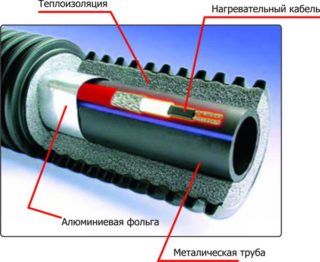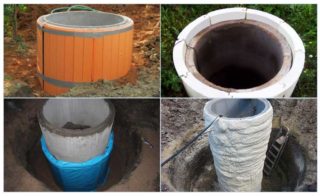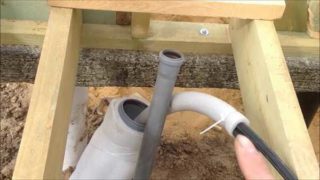During the construction of their own houses and the installation of utility networks, each prudent owner insulates the well. This is especially true in frosty climates, when in winter the temperature drops to -30 degrees and stays at this point for weeks. Any errors will lead to the fact that the insulation of the well will become less effective, this will lead to the need to carry out expensive repairs.
Warming Methods

There are different ways to warm wells and boreholes. Each of them has certain advantages and disadvantages. Experts recommend using several techniques at once in order to increase efficiency and not encounter problems in the future.
Installation of a caisson
One of the most popular methods for warming wells is using a caisson. You can make it yourself, which will cost less, or purchase ready-made - this option is suitable for owners of private houses that value time.
Installation is carried out in several steps:
- A pit is excavated, the lower point of which lies about 50 centimeters deeper than the level of freezing of the soil.
- At the bottom of the pit, a sand and gravel pillow is arranged - about 10 centimeters.
- In the caisson, holes are cut out for a pipe or several pipes, after which it is installed in place.
- All necessary equipment is installed, including a pump.
- The walls of the caisson are insulated from the outside - the thermal insulation must be resistant to moisture (penoplex will be a good choice) and have a thickness of about 50 mm.
- The caisson is closed with a heat-insulated lid and filled with soil - it is advisable to mix the earth with expanded clay in order to reduce the heat loss of the well.
Insulation of the caisson for the well does not require special skills and can be performed by a lay person.
Heating cable

For residents of the coldest regions of the country, the best way to warm a well for the winter with their own hands on the street is to use a heating cable. This is a very effective, but at the same time costly way — in order to warm the well, you have to expend electricity - not a lot, but constantly.
Installation is very simple - the soil around the pipe is removed, after which the cable is laid. Powerful can be laid in a straight line, the weak will have to be wound on a pipe. The weaker the heating, the less should be the step between the coils.
At the last stage, the pipe is filled up with the extracted soil.
Additional casing
Not the most effective way of insulation, but it’s cheap to install and free to use. It is often chosen for insulation of wells and plumbing in private homes. You need to follow a few steps:
- The soil around the pipe is removed.
- The pipe is insulated with high-quality thermal insulation. The larger the layer, the better.
- Over the insulation, another pipe is put on - casing - of a larger diameter.
- The casing is filled with earth.
For regions of Russia, where the temperature drops sharply in winter to -20 degrees and below, an additional casing is a great way to warm a well.
The choice of materials for warming the well

The choice of material depends on two factors: the depth of freezing of the soil and the level of occurrence of groundwater.
If the probability of freezing the well is small, you can use free natural heaters - sawdust, peat, old leaves, chopped straw.The main thing is to protect them from getting wet, otherwise the thermal insulation properties will drop sharply.
Also in warm areas you can build a warmed house for the well - it protects the water supply system reliably, during construction it is not necessary to carry out massive excavation work, digging a few cubic meters of soil. The house is installed directly on the surface of the earth and does not spoil the appearance of the site, with a design approach can complement the attractiveness of the house or cottage.
For a more severe winter climate, polyurethane foam, foam or basalt cotton wool is better. These heaters are the most effective of the widely used and not too expensive.
Polyurethane foam and penoplex are not afraid of moisture, and basalt wool, with all its advantages, easily absorbs it, losing effectiveness. Therefore, when using it, you need to take care of good waterproofing.
Structures for insulation
When warming wells, one should not forget about equipment. With a sharp cold snap, it can fail. First of all, these include:
- pump,
- automation controls the pump
- casing head.
The problem can be completely solved by installing a caisson. All equipment is in it and thanks to the heat coming from the water, the temperature does not fall below the permissible mark. In combination with good insulation, this solution is optimal.
Winter well protection
To build a pit, a pit is dug around the pipe. Its bottom should lie half a meter deeper than the depth of freezing of the soil. The main thing is not to get to the groundwater, if the level of occurrence is high enough. Otherwise, it will be necessary to solve the problem of their challenge.
The walls are strengthened. Concrete rings, bricks and other available materials can be used. Next, you need to insulate the pipe well. Wrapping with several layers of basalt wool, followed by a waterproofing layer, is suitable.
Passive insulation
Water in the well rises from a rather large depth, where the temperature never drops below zero. Therefore, in some cases, it is enough to simply save this heat so as not to resort to additional insulation.
In this case, a sump or caisson is perfect, followed by applying a good insulation above the level of soil freezing. But this option is good for a private house with year-round living. If you need to warm the well in the country, this method will have to be abandoned.
Even if there is a good insulation, the water, if it stands motionless for weeks, will cool and as a result will turn into ice, which can break the pipe. To prevent this, the well needs to be used regularly, thus warming up the water supply system.



